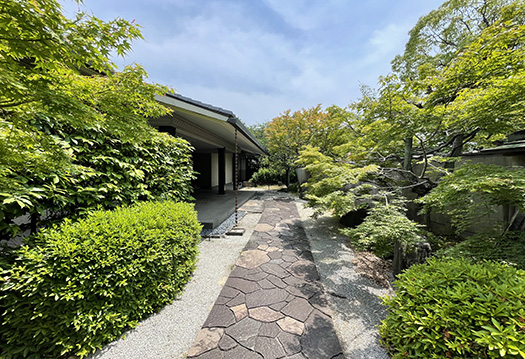
最近、日本各地、主に東京・関東と関西・中部地域の住宅探訪の機会が増えている。
まぁ人口規模でいえば8割程度の「住文化圏」地域ということになるだろうか。公開されている住宅、それも著名な事跡を残した人物の居宅という条件付きではあるので「中流」ではなく、一般的には「高級住宅」ではあるだろう。
そういう住宅では、日本人の住宅文化の「伝統」がより強く反映された様相をみせてくれる。北海道の住宅人として、そこで強く感じさせられるのが写真のような「庭」と住宅の関係。
言うまでもなく北海道では多くの地域で多量の「降雪」がある。
生活上、この雪に対して通常的な人間生活維持のためにある意味「戦い」を余儀なくされる。まずは人間同士の社会活動の維持・交流にとって、移動交通の最大の障害になってしまう。道路に大量の降雪があれば、必然的に人間生活は利便性を阻害されるので、あるいは除雪したり、堆雪場所と除雪空間を整理して仕分けて移動交通の便をつねに確保する必要性に迫られる。
冬の間、北海道人のアタマのなかには、この外的条件が徹底して刷り込まれてくる。否応ない、生活の困難との「戦い」に無条件で向かわなければ生きていけないのだ。
そういった気候条件下では、自分の生活空間の利便性確保が第一。そうなると、たとえば自宅の敷地が広大だとして、まずは公的な除雪がされた移動交通の「道路」に至るまでの生活通路の除雪が必要で、その絶対条件確保ということが最優先される。
そのような条件下では、写真のようなゆたかな「庭空間」を維持するための「冬囲い」も相当重厚に対策しなければ、春になってすべての庭木が全滅していることになる。
日本民族として、非常に新規性のある外部環境と言えるだろう。
必然的に北海道では庭という概念は、それまでの日本文化概念とは変容を余儀なくされる。北海道人にとっては庭木よりも、外での「バーベキュー空間」というような、いわば「花より団子」の方向に向かっていくことになる。奥ゆかしさ、というような日本生活文化に対しては、より即物的な方向に向かって行かざるを得ない。
一方で、写真のようなゆたかな植栽をその主人の人格表現、家の品格としても考える文化圏では、こういった「丹精込めた」庭との応答ぶりが、ライフスタイルの重要ポイントになる。
日本文化のキモにある「花鳥風月」は、実はこうした庭文化との精神的応答がいつしか伝統になってきた軌跡を表しているようにも思える。
日本人としての内面の文化性を共有する人間としては、こういった庭園美には深く癒される一方、これムリという内語を持たざるを得ない。
さてこういう不条理は、どのような落とし所に向かっていくのだろうかと、深く興味を持たざるを得ない。
English version⬇
The “Garden” Culture at the Core of Japanese Housing and Hokkaido
At the core of Japanese housing culture, there is a native culture and sense of values that respond to the beauty of gardens and love of flowers, birds, wind, and the moon. There is a huge gap between Hokkaido and Japan, which is impossible to realize as it is. The “garden” culture and Hokkaido
Recently, I have been having more and more opportunities to explore houses in various parts of Japan, mainly in the Tokyo-Kanto and Kansai-Chubu regions.
In terms of population size, these areas are about 80% of the “residential culture zone”. The houses are open to the public, and since they are the residences of famous people who have left their mark, they are not “middle class,” but are generally considered to be “luxury residences.
In such houses, the “tradition” of Japanese housing culture is reflected more strongly. As a house owner in Hokkaido, I am strongly impressed by the relationship between the “garden” and the house, as shown in the photo.
Needless to say, many areas in Hokkaido have a large amount of snowfall.
In our daily lives, we are forced to “fight” against this snow in a sense in order to maintain normal human life. First of all, it is the biggest obstacle to mobile transportation for the maintenance of social activities and interaction among humans. When there is a large amount of snowfall on the roads, human life is inevitably hampered by the necessity of clearing snow or organizing and sorting out snow storage areas and snow removal spaces to ensure the convenience of mobile transportation.
During the winter, these external conditions are thoroughly imprinted in the minds of the people of Hokkaido. They are forced to “fight” against the difficulties of life to survive.
Under such climatic conditions, the first priority is to secure the convenience of one’s living space. Then, for example, if the site of one’s home is vast, the first priority is to secure the absolute conditions for snow removal, which is necessary to remove snow from the living corridors leading to the “roads” for official snow removal of mobile traffic.
Under such conditions, if the “winter enclosure” to maintain a generous “garden space” like the one in the photo is not also heavily protected, all the garden trees will be completely destroyed in the spring.
As a Japanese ethnic group, this is a very novel external environment.
Inevitably, the concept of a garden in Hokkaido is forced to undergo a transformation from the previous Japanese cultural concept. Rather than gardens and trees, Hokkaidoans are now more interested in “barbecue space” outside, in the direction of “dumplings over flowers,” so to speak. In contrast to the Japanese lifestyle and culture, which is characterized by a sense of “modesty,” the direction of the Japanese people is toward a more immediate and materialistic approach.
On the other hand, in cultures that consider rich planting as an expression of the owner’s personality and the dignity of the house, such as the one in the photo, the response to a “meticulous” garden is an important aspect of the lifestyle.
Kacho-fu-getsu,” a key element of Japanese culture, seems to represent a spiritual response to the garden culture that has become a tradition over time.
As a person who shares the inner cultural nature of the Japanese, I am deeply comforted by the beauty of these gardens, but at the same time, I cannot help but have an internal language of “I can’t do this.
I cannot help but be deeply interested in how this kind of absurdity will be resolved.
Posted on 5月 27th, 2024 by 三木 奎吾
Filed under: 日本社会・文化研究







コメントを投稿
「※誹謗中傷や、悪意のある書き込み、営利目的などのコメントを防ぐために、投稿された全てのコメントは一時的に保留されますのでご了承ください。」
You must be logged in to post a comment.